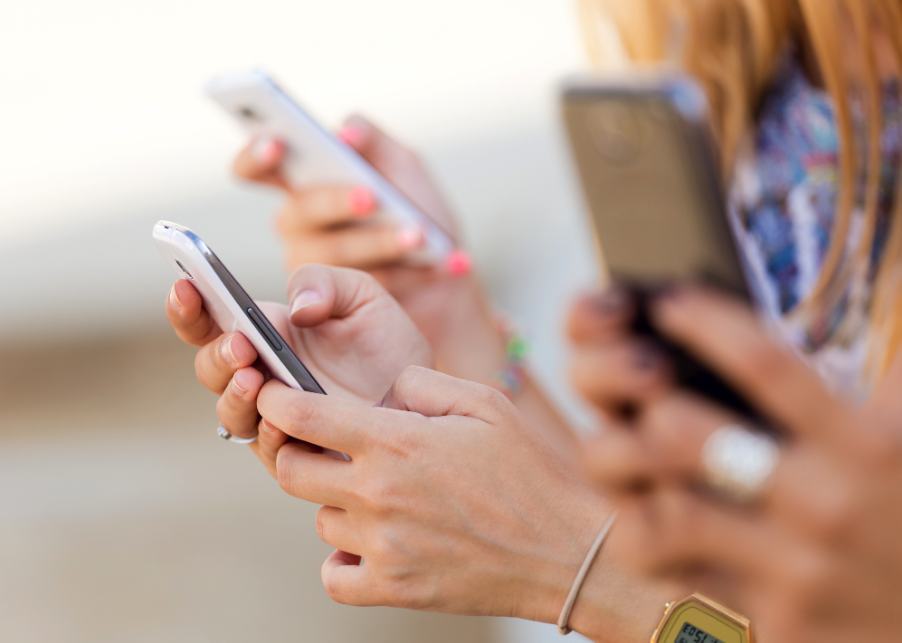The environmental impact of smartphones—and what the industry is doing to make them more sustainable

Josep Suria // Shutterstock
The environmental impact of smartphones—and what the industry is doing to make them more sustainable
Close-up of several hands holding smartphones.
Since the first cellphone call was placed from a New York City sidewalk in 1973, the mobile phone has revolutionized everything from our ability to simply communicate on the go to having an entire computer fit in the palms of our hands.
Though cellphones existed by the early ’70s—and car phones predated those by a decade or two—they weren’t widely accessible until the 1980s. And it wasn’t until the ’90s and early 2000s that they had shrunk in both size and price enough for most people to buy them.
Although mobile phone technology has constantly been evolving since its invention, cellphones were not always something people replaced on a yearly or biyearly basis. The introduction of the touchscreen smartphone changed that, with its less durable, easily crackable glass front and frequently changing software.
Today, at least 1 in 10 American survey respondents get a new smartphone every year, according to a poll published in 2022 by SlashGear. Most respondents said they wait two to three years before getting a new phone. Some of the most common reasons cited for replacing smartphones are worsening battery life, screen damage, camera quality, and trendiness, according to a survey by the German digital association Bitkom.
But as smartphone technology continues to break new ground year after year, the environmental toll of the relatively short life span of cellphones is becoming increasingly clear. Using reports, scientific studies, and government memos, Visible partnered with Stacker and looked into the environmental impact of smartphones and how the industry and governments are driving toward more sustainable solutions.
An estimated 5 billion phones ended up in landfills in 2022
From their production to their disposal, smartphones impact the environment in many ways. In 2022, smartphones generated 146 million tons of carbon dioxide emissions, most of which from their manufacture, shipping, and first year of use, according to a Deloitte report.
Smartphones require rare earth elements like lithium, neodymium, and antimony, all of which have limited supply, scientists have warned. This is particularly alarming considering these elements are used in green energy solutions like electric vehicles and wind turbines, key players in fighting the climate crisis. An additional environmental cost comes from the fact that rare earth elements, as well as precious minerals like cobalt, have historically been mined, causing ecological damage, although the technology now exists to recycle them from old devices.
Besides the toll of manufacturing smartphones, throwing cellphones away can cause serious damage to ecosystems and the people, plants, and animals inhabiting them. Cellphone batteries often contain arsenic and lead, which can leach into groundwater and other areas, causing illness. Mercury is also found in various cellphone components and has traveled into waterways to be ingested by fish, which are then ingested by humans.
Over 5 billion phones were estimated to be thrown away in 2022, according to the Waste Electrical and Electronic Equipment forum.
Alleviating the environmental cost of smartphones
Both the mobile phone industry and governing bodies worldwide are looking for more sustainable solutions as the e-waste crisis grows more dire. As a result, more eco-friendly phones, as well as more sustainable ways of processing them after they’ve been gotten rid of, have emerged.
There are numerous factors to look for in a more sustainable phone: whether it’s manufactured using recycled materials, uses more sustainable packaging, has a replaceable battery, offers a longer warranty period, or sells a repair module for at-home fixes. Many telecom and mobile phone companies have also introduced trade-in programs, which incentivize consumers to return their older devices for newer ones, allowing the companies to refurbish or reuse elements of phones that might otherwise have ended up in a landfill.
Governments are also introducing legislation and regulations that offset the environmental impact of smartphones. The European Parliament, for example, approved new rules for battery manufacturing in 2023 that will increase their durability, sustainability, and replaceability. This will impact everything from smartphones to other appliances and will likely lessen some of the e-waste currently being directed to landfills.
Along similar lines, the United Nations’ International Telecommunication Union set a target in 2018 to raise proper recycling of e-waste to 30% by 2023. The body also aimed to increase the percentage of countries with e-waste legislation to 50% by that same year.
In the U.S., both state- and federal-level governments are crafting their own legislation to deal with the crisis. In 2021, President Joe Biden signed an executive order mandating the Federal Trade Commission to create rules on consumers’ ability to repair certain goods, including electronics.
At the end of 2023, New York passed a “right-to-repair” law requiring electronics companies, including many phone companies, to ensure their parts, tools, and documentation could be purchased by independent repair shops and consumers. Other states—including Massachusetts, Colorado, Minnesota, and Maine—have passed similar laws. Right-to-repair legislation makes repairing devices, rather than replacing them outright, more accessible to consumers, a change that will also likely mitigate the environmental impacts of smartphones.
These are only some of the steps on the road to sustainability, so at the very least, before replacing that smartphone, think about whether it’s really necessary or if there are other greener options available. As Joy Scrogum, assistant scientist of sustainability at the Illinois Sustainable Technology Center, pointed out to Popular Science, “The ‘greenest’ device is the one you already own, or one previously owned by someone else.”
Story editing by Carren Jao. Copy editing by Paris Close. Photo selection by Clarese Moller.
![]()
